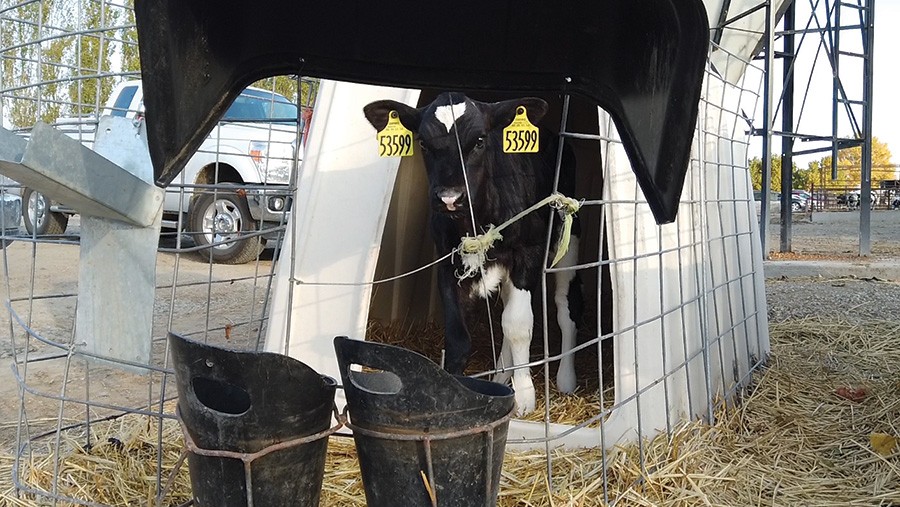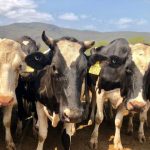
This is being achieved on both heifers and cows with voluntary waiting periods (VWPs) of 75 days and 55 days, respectively.
In the UK, the typical VWP before cows are bred after calving is 42 days – among the shortest seen worldwide, according to vet Dr Scott Abbott at Dairy Vet Management in Washington State, who is also director of technical services at World Wide Sires.
This is attributed to dairy farmers being fearful they will miss the opportunity to breed much later in lactation.
But many herds are proving this isn’t a reality, as long as heat detection is good.
Breeding goals and processes
The goal at the DeRuyter dairy is to have high-producing animals with 50% of them producing after third lactation.
Dr Abbott, the herd’s vet, says: “It’s a good driver for milk production but it also creates a very good story for the public – it means we are looking after our cows and they are surviving longer.”
Although they are not quite meeting this target yet, they have a clear strategy to start them on the right track.
Youngstock are genomic tested to identify the highest genetic merit animals. Then they use IVF and implant the embryos into first- and second-lactation animals.
Meanwhile, sexed semen is used on virgin heifers while the bottom-end animals get conventional semen or will be served to beef.
“We don’t put any embryos into heifers because these are the highest genetic animals within our herd already. Our aim is to breed from the best,” Dr Abbott adds.
DeRuyter uses a pre-synch programme within the herd and anything not detected within oestrus starts an ovsynch programme.
Typically, only 5% of animals will require timed AI for first breeding. Heats are detected manually by staff dedicated solely to this task, by walking the cows and using tail chalks with staff dedicated solely to this task.
“We wait longer to serve heifers because they produce more milk and are more persistent than cows,” Dr Abbott explains. “That’s why we need to get cows pregnant first but we’re not too worried about getting heifers pregnant as fast.”
Research supports this theory, with recent work suggesting shorter VWPs can hurt younger animals more. A study of UK herds found high-producing first lactation animals produced less milk in first and second lactation compared with those served later.
Dr Abbott refers to this as the “sophomore slump”. “If we breed first lactation animals too fast we see lower yields in first and second lactation and higher culling rates,” he says.
“If you breed a cow too soon and she gets pregnant we have left some money on the table. Heifers that get pregnant too soon in first lactation don’t have enough time to complete the growth cycle.
“This means they are still partitioning nutrition to that growth while on the milking ration and this impacts overall production.”
Breeding success
The numbers
30-35% Third lactation cows in most UK herds
At DeRuyters
38% Third lactation plus cows
26% Second lactation cows
36% First lactation cows
115 Average days open for first lactation cows
104 Average days open for second lactation cows
105 Average days open for third lactation cows
113 Total days open for all animals
11% Cows open at 150DIM
The dairy’s breeding programme is working so well that its average days open is just 113 days in total – including Do Not Breed (DNB) cows.
“The typical reason they are DNB is because they have failed to get pregnant and that’s where a lot of people cheat [by not including them in their calculations],” adds Dr Abbott.
Milk production is averaging 43 litres/day and cows are dried off while they’re still producing high levels of milk. Currently first lactation animals are dried off when they are doing 34 litres, second at 32 litres and third at 30 litres.
At DeRuyter, it is all about setting up every animal so she has a successful lactation. There’s no “myth or magic”, Dr Abbott says; it’s all about having simple protocols and following them,
Close-up cows are dry for 55 days. They spend 30 days on a close-up diet pre-calving and 15 days prior to calving they move into a state-of-the-art fresh cow barn, designed to maximise cow comfort and airflow, where heifers and cows never comingle.
They are given 100cm a cow of feed bunk space, 75cm a cow of water trough room and deep, straw beds to lie down. Heifers and cows are kept separately and the aim is for heifers to calve in at 90% of mature weight (around 630-650kg liveweight).
Dr Abbott says: “For me, there’s no question that what makes their programme successful is two things: heifers are the right size at calving and their transition programme is spot on.”
Advice for assessing your VWP
Look at your average days to conception. Is it meeting target?
Assess your failure rate. How many cows are failing to get pregnant by 150 days in milk (DIM) including Do Not Breed (DNB)? If this is higher than 10% you may not be able to lengthen your VWP but remember, fertile cows will get pregnant sooner whatever you protocols. Your focus should be on the ones that are bred later because these are your stale cows that will be losing you money.
What’s your retention rate? Are cows leaving your herd too soon? The top three reasons for cows leaving the herd before 60 (DIM) is somatic cell count, lameness and poor reproduction. Get to the bottom of what’s causing the issue.
Have a conversation with your vet or breeding adviser to see how you may be able to fine-tune things. This may be a combination of using more conventional/sexed semen or lengthening your VWP for certain groups.
Targets to aim for
Average days in milk 170
Percentage open over 150 DIM Goal of <10% and critical point of >15%
Average days open first lactation 110-115
Average days open second lactation 105
Average days open third lactation 90-100
Pre-synch ovsynch programme
Day 0 Calving – aim to drive high dry matter intake
Day 40 Give Prostaglandin to start a new cycle/return cows to heat
Day 54 Second dose of PG given
Day 55 VWP for cows. Any heats detected and cows served
Day 66 Non-bred cows given Gonadotrophin-releasing hormone (GnRH) to stimulate the release of follicles. Heat detection continued
Day 73 PG given
Day 75 Another GnRH injection administered
Day 76 Timed AI 16 hours later























